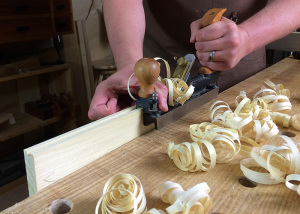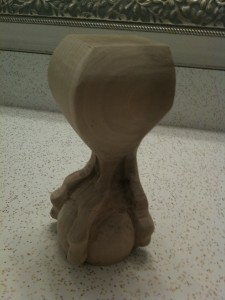Difficult is Just Easy Work Done Slowly
What was the last difficult moment you had with a project? Was it a particularly complex joint or a nasty bit of figured grain? How did you tackle it? I bet the solution regardless of the tools being used was to slow down and take care of it meticulously. If you think about it, “difficult” tasks just force us to slow down. Sometimes to glacial speeds.
So when you look at it that way, no project is really that hard to make, but rather just slower.
Its quite liberating!
I’m a firm believer that any woodworker of any skill level should feel free to tackle any project that strikes their fancy. Woodworking is just a series of individual tasks, often repeated many many times. Break down those tasks far enough and you will see just how simple a project can be. For that matter the tools we use to do those tasks play a major role in how “difficult” it is to accomplish.
 Consider the humble groove for, say, a drawer bottom. Cut with a hand held router and a bearing guided bit and this is fast and easy. The slow bit is in setting the bit height and securing the work piece. Now drop that router into a table with a lift and the groove becomes even easier (faster). On the non powered front, using a plow plane is just as easy. Set the fence and depth stop and the joint is a cinch. But take away the plow plane and hand the woodworker just a chisel. Funny how “difficult” that simple groove is now. But the act of using a chisel to chop out a groove is as simple and easy as can be, but you have to go slowly and meticulously lay out the extents of the groove and be careful of taking to heavy a bite with the chisel while ensuring you maintain an equal depth. There are a lot of variables to keep track off that we relied on fences and depth stops and bearings with other tools.
Consider the humble groove for, say, a drawer bottom. Cut with a hand held router and a bearing guided bit and this is fast and easy. The slow bit is in setting the bit height and securing the work piece. Now drop that router into a table with a lift and the groove becomes even easier (faster). On the non powered front, using a plow plane is just as easy. Set the fence and depth stop and the joint is a cinch. But take away the plow plane and hand the woodworker just a chisel. Funny how “difficult” that simple groove is now. But the act of using a chisel to chop out a groove is as simple and easy as can be, but you have to go slowly and meticulously lay out the extents of the groove and be careful of taking to heavy a bite with the chisel while ensuring you maintain an equal depth. There are a lot of variables to keep track off that we relied on fences and depth stops and bearings with other tools.
Its the same joint but each method discussed above takes different amounts of time and can therefore be perceived as more difficult than another.
Now I have cut grooves using all of these methods (plus a few more) and one quickly learns that this “difficult” joint can be made easier by bringing to bear a different tool. But that’s not always the case. Whether because the best tool is cost prohibitive or just so specific as to not be logical for a unique situation. But there are also times when no matter what tool you throw at the problem, it won’t speed things up. These tasks are the truly difficult ones that scare many a woodworker away.
 For me it was the ball and claw foot. There were several lovely furniture pieces I wanted to build but they all included the ball and claw foot. I loved this detail and didn’t want to skip it so I seemed to have no option but to either cower in fear or suck it up and learn to carve this detail.
For me it was the ball and claw foot. There were several lovely furniture pieces I wanted to build but they all included the ball and claw foot. I loved this detail and didn’t want to skip it so I seemed to have no option but to either cower in fear or suck it up and learn to carve this detail.
My first example took me about 5 hours but when finished it looked really good. I would not have hesitated to use it in a project. There was no way to speed this up other than make some more and to get more comfortable with the steps and with the carving gouges. But as evidenced by the respectable appearance of my first foot, it wasn’t hard at all, just slow.
Hopefully you are starting to see what I’m talking about and perhaps that bucket list project of yours went from scary and difficult to something that you just need to slow down and get done.
Your Turn
Name a difficult woodworking task that has you stumped. I bet we can figure out an easy way to do it slowly.


